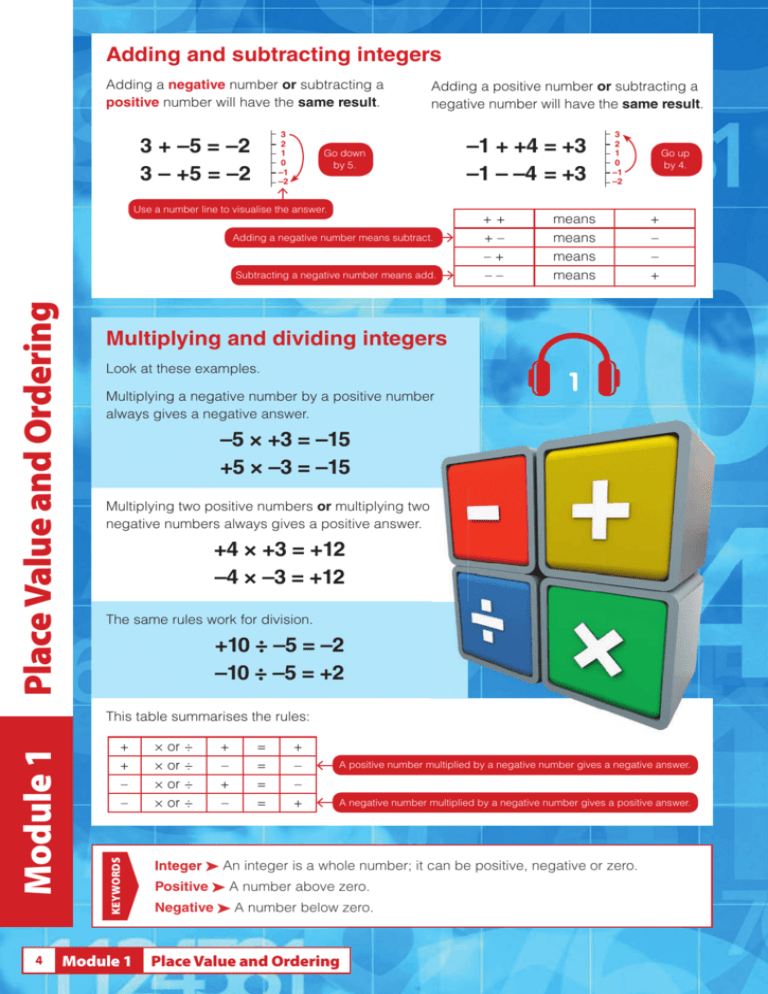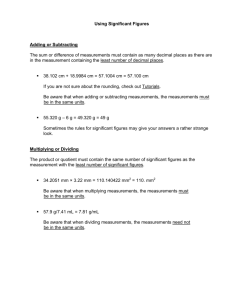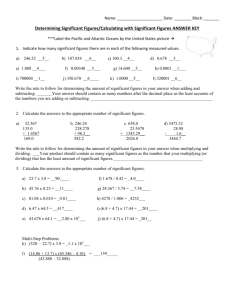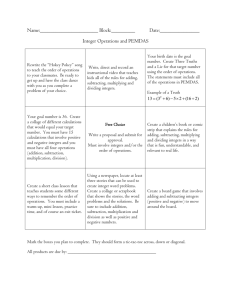1 - Collins
advertisement

Adding and subtracting integers Adding a negative number or subtracting a positive number will have the same result. 3 2 1 0 –1 –2 3 + –5 = –2 3 – +5 = –2 Adding a positive number or subtracting a negative number will have the same result. Go down by 5. Factors, Place Value Multiples and Ordering and Primes Use a number line to visualise the answer. Adding a negative number means subtract. Subtracting a negative number means add. Multiplying and dividing integers Sub Header Look at these examples. Main Copy Multiplying a negative number by a positive number always gives a negative answer. Main Copy –1 + +4 = +3 –1 – –4 = +3 ++ +– –+ –– 3 2 1 0 –1 –2 means means means means Go up by 4. + – – + 1 –5 × +3 = –15 Main Copy No Space Main Copy No Space +5 × –3 = –15 Main Copy No Space Main Copy No Space Multiplying two positive numbers or multiplying two Main Copy negative numbers always gives a positive answer. Maths symbols: +4 × +3 = +12 –4 × –3 = +12 The same rules work for division. +10 ÷ –5 = –2 –10 ÷ –5 = +2 4 + + – – KEYWORDS Module 1 2 This table summarises the rules: × or ÷ × or ÷ × or ÷ × or ÷ + – + – = = = = + – – + A positive number multiplied by a negative number gives a negative answer. A negative number multiplied by a negative number gives a positive answer. An integer is a whole number; it can be positive, negative or zero. Positive Negative A number above zero. A number below zero. Place Value Multiples and Ordering and Primes Module 1 2 Factors, Use of symbols Look at the following symbols and their meanings. Symbol > < > < = ≠ Meaning Examples Greater than 5 > 3 (5 is greater than 3) Less than –4 < –1 (–4 is less than –1) Greater than or equal to x > 2 (x can be 2 or higher) Less than or equal to x < –3 (x can be –3 or lower)) Equal to 2 + +3 = 2 – –3 Not equal to 42 ≠ 4 × 2 (16 is not equal to 8) Place value Look at this example. Given that 23 × 47 = 1081, work out 2.3 × 4.7 The answer to 2.3 × 4.7 must have the digits 1 0 8 1 Do a quick estimate to find where the decimal point goes. 2.3 is about 2 and 4.7 is about 5. Since 2 × 5 = 10, the answer must be about 10. Therefore 2.3 × 4.7 = 10.81 Write the following symbols and numbers on separate pieces of paper. + – × ÷ = 0 +2 –2 +4 –4 +8 –8 Arrange them to form a correct calculation. How many different calculations can you make? For example: +2 – –2 = +4 1. Calculate the following: (a) –5 – –8 (b) –2 + –6 (c) –7 + –3 – –5 2. Calculate the following: (a) –12 × –4 (b) 24 ÷ –3 (c) –3 × –4 × –5 3. State whether these statements are true or false. (a) 6 < 3 (b) –4 > –5 (c) 2 + –3 = 2 – +3 4. Given that 43 × 57 = 2451, calculate the following: (a) 4.3 × 0.57 (b) 430 × 570 (c) 2451 ÷ 5.7 Factors, PlaceMultiples Value and and Ordering Primes Module 2 1 5 18 Number Mind Map Upper and lower bounds Rounding Decimal places Place value Significant figures Estimation Improper Negatives Powers Reciprocals Mixed numbers Highest common factor Prime factors Standard form Lowest common multiple Integers Calculators Fractions Number Bidmas Four operations Approximations Decimals Mind Map Recurring Percentages Number Index notation Index laws Squares, cubes and roots 1. Work out the following. (a) 4 × 5.8 [2] (b) 2.3 × 42.7 [3] (c) 24 ÷ 0.08 [2] (d) 46.8 ÷ 3.6 [2] (e) –3 + –4 [1] (f) –2 – –5 + –6 [1] (g) 45 ÷ –9 [1] (h) –4 × –5 × –7 [1] (i) 4 + 32 × 7 [1] (j) (5 – 62) – (4 + [2] 2. (a) Write 36 as a product of its prime factors. Write your answer in index form. [2] (b) Write 48 as a product of its prime factors. Write your answer in index form. [2] (c) Find the highest common factor of 48 and 36. [2] (d) Find the lowest common multiple of 48 and 36. [2] 3. (a) Work out the following. 4×5 3 6 [2] Write your answer as a mixed number in its simplest form. (b) The sum of three mixed numbers is 711. Two of the numbers are 2 3 and 3 5 . 12 4 6 Find the third number and give your answer in its simplest form. [3] (c) Calculate 3 1 ÷ 2 1 . 5 4 Give your answer as a mixed number in its simplest form. [3] 4. Simplify the following. (a) 53 ÷ 5–5 [1] (b) 98 [1] (c) 7(4 − 3 7) [2] 5. Evaluate the following. (a) 2.30 [1] (b) 9 − 1 2 4 [2] (c) 27 3 [2] 6. (a) Write the following numbers in standard form. (i) 43 600 [1] (ii) 0.008 03 [1] (b) Calculate the following, giving your answer in standard form. (1.2 × 108) ÷ (3 × 104) 7. [2] Prove the following. You must show your full working out. • • (a) 0.4 8 = • • (b) 0.12 3 = 61 [2] 16 [2] 33 Exam Practice Questions 25 ) 495 (a) 7 [2] 5 (b) 3 [2] 1+ 2 9. Paul’s garage measures 6m in length to the nearest metre. His new car measures 5.5m in length to 1 decimal place. Is Paul’s garage definitely long enough for his new car to fit in? Show your working. [3] 10. a = 4.3 and b = 2.6 to 1 decimal place. a Find the minimum value of b and give your answer to 3 decimal places. [3] Exam Practice Questions Number Number 8. Rationalise the following surds. 19




